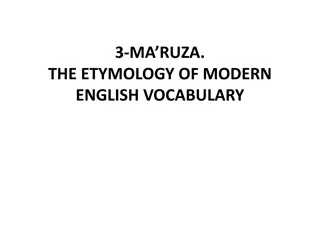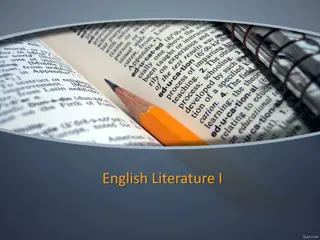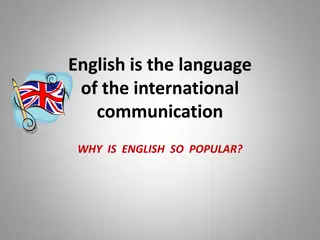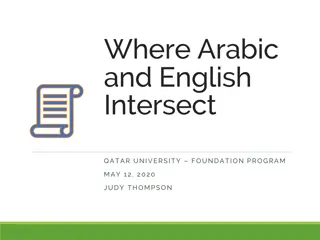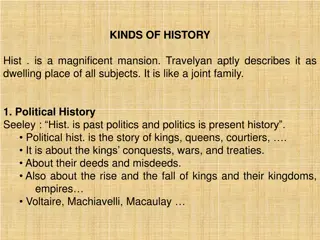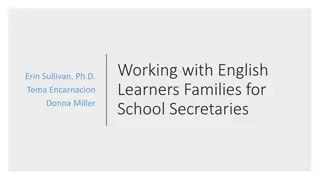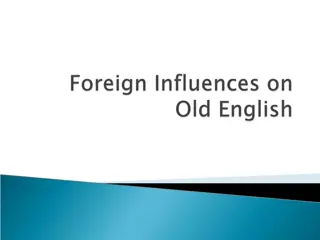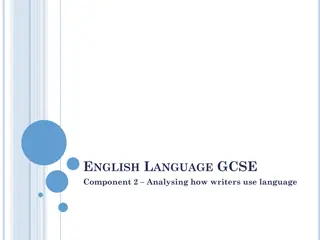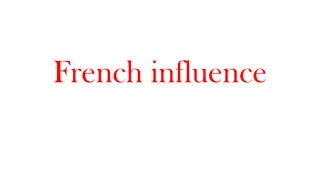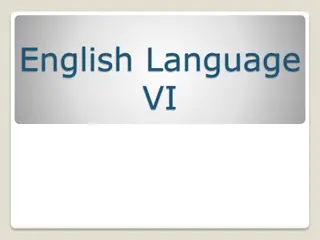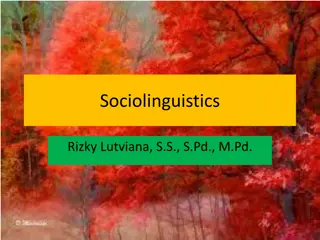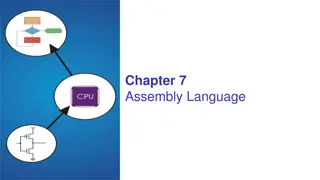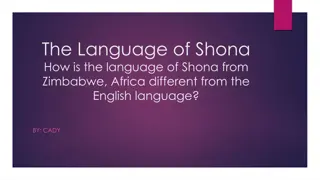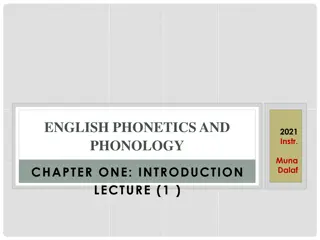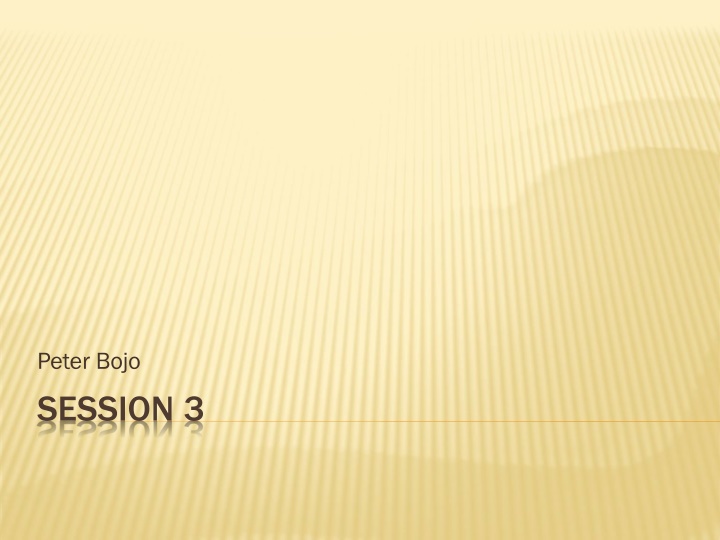
Understanding Language Classification and Development
Explore the fascinating world of language classification through genetic, typological, and areal perspectives. Discover how languages develop over time and influence one another. Delve into the evolution of English and the Indo-European language family.
Download Presentation

Please find below an Image/Link to download the presentation.
The content on the website is provided AS IS for your information and personal use only. It may not be sold, licensed, or shared on other websites without obtaining consent from the author. If you encounter any issues during the download, it is possible that the publisher has removed the file from their server.
You are allowed to download the files provided on this website for personal or commercial use, subject to the condition that they are used lawfully. All files are the property of their respective owners.
The content on the website is provided AS IS for your information and personal use only. It may not be sold, licensed, or shared on other websites without obtaining consent from the author.
E N D
Presentation Transcript
Peter Bojo SESSION 3
LANGUAGE CLASSFICIATION Areal classification Genetic classification Typological classificiation a) Lexical typology b) Syntactic typologly c) Phonological typology d) Morphological typology
AREAL CLASSIFICATION Languages used by neighbouring communities, although not being genetically related, sometimes influence each other and get similar features CONVERGENT DEVELOPMENT they become more similar and form various language groups. E.g. Bulgarian (Slavonic), Romanian (Romance)
GENETIC CLASSIFICATION Based on historical relationship between languages Languages evolved from a single parent language belong to the same language family E.g. English, Italian Russian and other languages all developed from Sanskrit a pre- historic Proto-Indo-European language. E.g. bhr tar bhr tar (sanskrit), frater (English) a formal resenblance may be seen frater Latin, brother brother
TYPOLOGICAL CLASSIFICATION Lexical typology Lexical typology: based on lexical difference 1. 1. explicit type explicit type express meaning of the word explicitly, 2. 2. condensed type condensed type basic semantic components are expressed by word-formation morphemes. Syntactic typology Syntactic typology: according to sentence patterns: English SVO type, Welsh VSO type,
Phonological typology 1. consonantic consonants prevail, 2. Vocalic vowels prevail Morphological typology: based on morphological structure of words: a) analytic, b) synthetic introflectional agglutinative polysynthetic Intraflectional grammatical categories expressed by a change inside the word. E.g. Arabic kalbun dog, kilabun - dogs Polysynthetic complex word forms function as whole sentences, REDUPLICATION: Indonesian orang person, orang orang - people
DEVELOPMENT OF ENGLISH Indo-European languages Germanic languages Old English Middle English Modern English
INDO-EUROPEAN LANGUAGES Proto-Indo-European language http://andromeda.rutgers.edu/~jlynch/language.gif
GERMANIC LANGUAGES Germanic languages
ENGLISH Part of Beowulf Old English (4th 11th cen) G. Chaucer Middle English (1100 1500) Early Modern English (1500 1800) Late Modern English (1800 Present) Hamlet by Shakespeare
OLD ENGLISH Celtic influence names of towns, rivers, regions (London, Avon, Kent...) When Old Saxons started settling, Britain still Roman province Old Saxons controlled the country until 700 3 main Germanic tribes
Old Saxons North-West Germany Angles Denmark Jutes Jutland (Denmark) http://downloads.bbc.co.uk/rmhttp/schools/primaryhistory/images/anglo_saxons/who_were_the_anglo-saxons/anglo-saxon_map.jpg
West Saxon language established as literary standard Language influenced by words of Scandinavian origin: take, window, anger, knife...
http://www.youtube.com/watch?v=D4058Zk2 Uv4 Hringas r e odnum lfa, allra ldestum, ofer eormengrunde. Hringas seofun innan sele st nnum Dwergdryhtnum. Derc heara h s. Hringas nigon n ote Moncynn, hl fordas m ra m gas d a f ge. Heolstres Hearra hring nne wearda in dryhtsele dimmum on dercan rymmsetle r licga scedwa in londe Mordores. Hring n gewalde, hring n gefinde, hring n gebringe, hring n gebinde oda sw owas in ostrum t gedere r licga scedwa in londe Mordores. Three Rings for the Elven-kings under the sky, Seven fo the Dwarf-lords in their halls of stone, Nine for Mortal Men doomed to die, One for the Dark Lord on his dark throne In the Land of Mordor where the Shadows lie. One Ring to rule them all, One Ring to find them, One Ring to bring them all and in the darkness bind them In the Land of Mordor where the Shadows lie.
MIDDLE ENGLISH Battle of Hastings 1066 native English aristocracy destroyed French language of ruling class English preserved its Germanic structure 13th Century tendency of English Population to return to English
1362 English was made the official language of the law-courts East Midland region dialect new language standard of the country Grammar two inflectional systems Old English, Old Norse Number of noun cases reduced to 3 (Nominative, Genitive, Accusative)
MODERN ENGLISH Around 1700 Latin still had prestige Bible translated into English English got the prestige Latin still spoken by scholar and highly educated people Modern English changes (grammar + vocabulary)
CHANGES IN GRAMMAR AND VOCABULARY e en n plural replaced by eth 3rd p.sin- eth eth morpheme replaced by es ending later - /-s/, /-z/, /iz/ allomorphs Difference between sin. and pl. past forms disappeared The perfective aspect was used with auxiliaries be and have morpheme. For example, the phonetic (s) of cats (k ts), (z) of pigs (p gz), and ( z) horses (h r s z) are allomorphs of the English plural eth es allomorphs ALLOMORPH: Any of the variant forms of a morpheme.
CHANGES IN PRONUNCIATION Great Vowel Shift long English vowels became diphtongs diphtongs or were raised New consonant phonemes - / / - no more a mere allophone of /n/ phoneme, / / phoneme developed from /zj/ /k/ and /w/ still pronounced in words like knight and write /x/ still pronounced in words like daughter and rough /w/ dropped in the pronunciation before some back rounded vowels (sword, who...etc) Its roundedness is protruded, which means that the corners of the lips are drawn together, and the inner surfaces exposed. Its vowel backness is back, which means the tongue is positioned as far back as possible in the mouth without creating a constriction that would be classified as a consonant.
OTHER CHANGES /r/ sound disappeared before a pause or a consonant (18th Cen, non-rhotic varieties New Zealand, South Africa...) Disappearance of /r/ sound caused the lengthening of previous vowel arm / m/ /r/ sound was preserved in Rhotic varieties (e.g. North American English) - / rm/
18TH CENTURY SCIENTIFIC PROGRESS Many new words coined Giving the existing forms new meaning (e.g. physics power) Borrowing words from other languages (Greek larynx, Latin vertebra, Greek barometer)
THANK YOU! PBOJO@CAMBRIDGE.ORG



